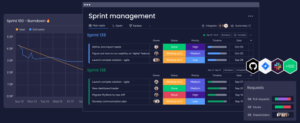
HR analytics and reporting serves as a vital tool for organizations seeking to enhance their workforce management strategies. By leveraging data-driven insights, companies can unlock a treasure trove of information that informs better decision-making in recruitment, talent management, and employee engagement. This approach not only streamlines HR processes but also aligns human resources with broader business objectives, ensuring a more cohesive and productive workplace.
The ability to gather, analyze, and report on HR data has become increasingly important in today’s fast-paced environment. Organizations that embrace HR analytics can gain a competitive edge, improve employee satisfaction, and foster a culture of continuous improvement. From understanding key metrics to navigating ethical considerations, this discussion delves into the multifaceted world of HR analytics and reporting.
Understanding HR Analytics
HR analytics is a strategic approach that leverages data analysis to enhance human resource management. In modern organizations, it plays a crucial role by providing insights that inform decision-making and improve workforce performance. The importance of HR analytics lies in its ability to transform raw data into actionable intelligence that drives organizational success.Key components of HR analytics processes include data collection, analysis, and interpretation.
Organizations typically assess employee performance, turnover rates, and recruitment efficiency as part of their analytics strategy. By employing various analytical techniques, HR teams can identify trends, predict future outcomes, and make informed decisions.For instance, in recruitment, HR analytics can be used to evaluate the effectiveness of different hiring channels. By analyzing the data, organizations can determine which sources yield the best candidates, thereby optimizing their recruitment strategies.
Similarly, in talent management, analytics can help track employee development and engagement levels, ensuring that talent is nurtured effectively.
Data Collection Methods in HR Reporting
Data collection is foundational to effective HR reporting. Various data sources contribute to a comprehensive understanding of employee dynamics, including internal databases, surveys, and external labor market data. Utilizing diverse sources enhances the richness of the insights generated.Organizations employ a range of tools and technologies for collecting HR data, such as Human Resource Information Systems (HRIS), applicant tracking systems, and performance management software.
These tools facilitate the efficient gathering and processing of data, which is crucial for timely reporting.To ensure data accuracy and integrity in HR reporting, best practices include regular audits, data validation checks, and providing training to HR personnel on data management. Establishing clear protocols for data entry and maintenance can significantly reduce errors and enhance the reliability of reports.
Key Metrics in HR Analytics
Tracking essential HR metrics is vital for organizations aiming to optimize their human resource functions. Key metrics can be classified into qualitative and quantitative categories, providing a holistic view of HR performance.Qualitative metrics may encompass employee satisfaction surveys, while quantitative metrics could include turnover rates, time-to-hire, and employee productivity levels. Monitoring these metrics helps organizations understand workforce dynamics and identify areas for improvement.Implications of these metrics on business strategy are significant.
For example, high turnover rates may indicate underlying issues within the workplace culture, prompting strategic changes that enhance retention. By leveraging metrics effectively, HR can align its strategies with broader business goals.
The Role of HR Analytics in Employee Engagement
HR analytics plays a critical role in influencing employee satisfaction and retention rates. By analyzing engagement data, organizations can identify factors that contribute to a positive work environment. This data-driven approach enables HR to implement targeted initiatives aimed at enhancing employee morale.A notable case study illustrates the impact of HR analytics on workplace culture. A leading tech company utilized analytics to assess employee feedback and identify pain points related to workload and team dynamics.
As a result, they launched programs to promote work-life balance, leading to increased employee satisfaction and lower turnover.To measure employee engagement effectively, a framework can be developed that includes metrics such as participation rates in engagement surveys, feedback on leadership effectiveness, and employee recognition programs. This framework helps organizations gauge the overall health of their workplace culture.
Integration of HR Analytics with Business Operations
Aligning HR analytics with overall business objectives is essential for maximizing its impact. When HR strategies are integrated with organizational goals, it enhances the relevance of HR initiatives in driving business performance.Challenges in integrating HR analytics into existing business processes may include resistance to change, lack of data literacy among staff, and insufficient resources for analysis. Overcoming these challenges requires a commitment to fostering a data-driven culture within the organization.To effectively communicate HR analytics insights to other departments, organizations can employ storytelling techniques that highlight the relevance of data to business outcomes.
Presenting data in a clear and engaging manner helps ensure that HR insights are recognized and valued across the organization.
Ethical Considerations in HR Analytics
Using employee data for analytics carries ethical implications that organizations must navigate carefully. It’s essential to balance the benefits of analytics with the responsibility to protect employee privacy and comply with regulations like GDPR.Best practices to safeguard employee privacy include implementing strict data access controls, anonymizing data where possible, and ensuring transparency about how data is used. By prioritizing ethical considerations, organizations can build trust with their employees while fully leveraging the power of HR analytics.When comparing ethical concerns in HR analytics with those in other business areas, it’s evident that employee data requires a higher standard of care due to the sensitive nature of personal information.
Organizations must remain vigilant in addressing these ethical challenges.
HR Analytics and Customer Service
HR analytics significantly enhances customer service delivery by optimizing staff training and development programs. By analyzing HR data, organizations can identify skill gaps in their workforce and tailor training initiatives to improve customer interactions.For example, a retail company utilized HR analytics to assess employee performance in customer service roles. By identifying top performers, they developed a mentorship program that helped elevate the skills of less experienced staff, resulting in improved customer satisfaction ratings.Additionally, by integrating HR analytics into customer service strategies, organizations can gather insights into employee engagement levels, which directly correlate with customer experience.
When employees are satisfied and engaged, they are more likely to provide exceptional service.
HR Analytics and Entrepreneurialism
HR analytics influences entrepreneurial ventures and startups by providing insights that help create effective teams. New businesses can leverage analytics to identify the right talent, understand workforce dynamics, and build a culture that fosters innovation.Startups often face unique challenges in building teams, and HR analytics can assist in aligning recruitment strategies with business goals. By analyzing data on past hiring successes, entrepreneurs can refine their selection processes to attract candidates who fit their organizational culture.The correlation between HR analytics and innovation in entrepreneurial settings is evident in companies that prioritize data-driven decision-making.
By leveraging analytics, startups can enhance creativity and agility, ensuring they remain competitive in rapidly evolving markets.
Implementing HR Analytics in Business Franchising
HR analytics plays a significant role in managing franchise operations. By utilizing analytics, franchisees can optimize staff performance and enhance operational efficiency, which is crucial for success in competitive markets.Strategies for franchisees to leverage HR analytics include using data to monitor employee performance across locations, identifying best practices, and implementing standardized training programs. These strategies help ensure a consistent customer experience and operational excellence.A checklist of key metrics for franchisors to monitor through HR analytics may include employee turnover rates, training completion rates, and customer feedback scores.
Monitoring these metrics enables franchisors to support franchisees effectively and drive overall brand success.
HR Analytics for Furnishings and Supplies Industry

The furnishings and supplies industry faces specific HR challenges, such as high turnover and seasonal workforce fluctuations. HR analytics can address these challenges by providing targeted insights into workforce management.For instance, by analyzing turnover data, organizations in this sector can identify factors leading to employee departures and develop retention strategies. Practical applications of HR analytics may include adjusting recruitment strategies to attract candidates who align with the company’s values.A comparative table of HR metrics unique to the furnishings and supplies industry could include turnover rates, employee satisfaction scores, and seasonal staffing needs.
This analysis allows organizations to benchmark their performance against industry standards.
The Future of HR Analytics
Predictions for the evolution of HR analytics over the next decade indicate a trend toward increased automation and integration with artificial intelligence. As technology advances, HR analytics will become more sophisticated, enabling organizations to gain deeper insights into employee behavior.Emerging technologies, such as machine learning and predictive analytics, will shape the future of HR analytics by providing tools for real-time data analysis.
Businesses that embrace these advancements will be better positioned to respond to workforce dynamics and drive strategic initiatives.To prepare for advancements in HR analytics, organizations should invest in training their HR teams on new technologies and fostering a culture of data-driven decision-making. By staying ahead of the curve, businesses can leverage HR analytics to gain a competitive advantage.
Industrial Mechanical Sector and HR Analytics
The industrial mechanical sector has unique HR needs, including a focus on skilled labor and safety compliance. HR analytics can enhance operational efficiency by identifying trends related to workforce performance and safety incidents.Key HR analytics applications in this field may include tracking employee certifications, analyzing incident reports, and assessing training effectiveness. By leveraging these insights, organizations can improve safety outcomes and workforce competency.A case study demonstrating the successful implementation of HR analytics in an industrial mechanical organization highlights how data-driven strategies led to a decrease in workplace accidents and improved overall productivity.
This illustrates the potential of HR analytics to drive significant improvements in operational performance.
Last Recap
In conclusion, HR analytics and reporting is not just a trend but a fundamental shift in how organizations approach their workforce challenges. By effectively utilizing data, businesses can enhance their operational efficiency, optimize employee engagement, and position themselves for future growth. As we look ahead, it’s clear that the integration of advanced HR analytics will play a pivotal role in shaping the workplace of tomorrow, making it critical for organizations to stay ahead of the curve.
Questions Often Asked
What is HR analytics?
HR analytics refers to the process of collecting and analyzing workforce data to improve HR decisions and outcomes.
Why is HR reporting important?
HR reporting provides insights that help organizations monitor performance, manage compliance, and drive strategic planning.
What are common data sources for HR analytics?
Common data sources include employee surveys, performance evaluations, payroll systems, and recruitment databases.
How can HR analytics improve employee retention?
By analyzing data on employee satisfaction and turnover trends, organizations can identify areas for improvement and implement targeted retention strategies.
What tools are used in HR analytics?
Popular tools include HR management systems, data visualization software, and analytics platforms that help interpret complex data sets.





